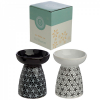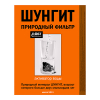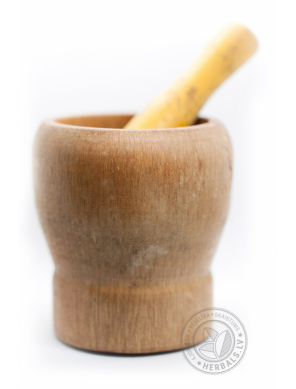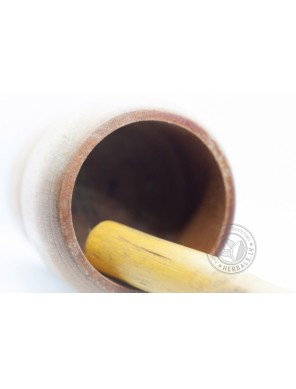Products
- Ayurvedic tea
- Indian teas
- Supplements
- Oils and drinks for health
- Facial Care
- For Skin
- Dental care
- For personal hygiene
- Sport and Yoga
- For Hair Health
- For massage
- Healthcare
- For Women
- Supplements for Men
- Aromatherapy Essential Oil
- Incense sticks
- Indian Food
- Vegan
- Superfoods
- For meditation
- For home
- New Products
- Specials
- Ayurvedic Herbs
- Wholesale
- Gifts and Kits
Browser notifications:
Wooden Mortar
Wooden Mortar & Pestle
Wooden Mortar
10х11cm
For grinding foods to transform their texture and release their full aroma and flavor, nothing beats a good mortar and pestle.
For thousands of years, the mortar and pestle was one of the very few implements our ancestors relied upon to cook. Our predecessors had fire, sharpened rocks for cutting, vessels to contain their food, and, crucially, they had stones and wood to pound and grind it all.
Today, the mortar and pestle remains a crucial tool in culinary traditions around the world, and it deserves to be treated as an essential in every kitchen. Not just because it served our ancestors so well, but because it continues to do what no other item in the kitchen does: smashing fibers and cells apart to fundamentally transform their texture and release their full aroma and flavor. That's something a blade can't ever do as well.
An evenly round bowl shape makes it much easier to swirl the pestle and grind everything in its path. Cylindrical mortars with sharp corners at the bottom are harder to get into with the pestle, making it more difficult to grind and smash the contents down.
Wooden Mortar Pestle Herb Grinding Set Garlic Crusher Spice Mixing Bowl Kitchen OR press Herb Spice grinder.
Mortars are used in cooking to prepare wet or oily ingredients such as guacamole, hummus and pesto (which derives its name from the pestle pounding), as well as grinding spices into powder. The molcajete, a version used by pre-Hispanic Mesoamerican cultures including the Aztec and Maya, stretching back several thousand years, is made of basalt and is used widely in Mexican cooking. Other Native American nations use mortars carved into the bedrock to grind acorns and other nuts. Many such depressions can be found in their territories.
In Japan, very large mortars are used with wooden mallets to prepare mochi. A regular sized Japanese mortar and pestle are called a suribachi and surikogi, respectively. Granite mortars and pestles are used in Southeast Asia, as well as Pakistan and India. In India, it is used extensively to make spice mixtures for various delicacies as well as day to day dishes. With the advent of motorized grinders, use of the mortar and pestle has decreased. It is traditional in various Hindu ceremonies (such as weddings, and upanayanam) to crush turmeric in these mortars.
In Malay, it is known as batu lesung. Large stone mortars, with long (2–3 foot) wood pestles were used in West Asia to grind meat for a type of meatloaf, or kibbeh, as well as the hummus variety known as masabcha. In Indonesia and the Netherlands mortar is known as Cobek or Tjobek and pestle is known as Ulekan or Oelekan. The chobek is shaped lke a deep saucer or plate. The ulekan is either pistol-shaped or an ovoid. It is often used to make fresh sambal, a spicy chili condiment, hence the sambal ulek/oelek denote its process using pestle. It is also used to grind peanut and other ingredients to make peanut sauce for gado-gado.
Developing childs motor skills - also can be used as toy
Mood Mortar and Pestle presents a Practical Life skill while promoting motor strength and coordination and evoking the Sensorial benefits of being surrounded by the scents of the herbs!
If your child does not already have access to a mortar and pestle it is time to get one now! Such a useful tool for developing a child's gross motor and fine motor coordination, as well as encouraging concentration and attention to detail. The mortar and pestle set can be used as an isolated activity or can be utilised in real cooking experiences to help your child feel empowered and involved!
The mortar and pestle activity can be easily adjusted for a wide range of purposes and skill-levels. A young child can begin by learning to crush small quantities of soft substances (such as 'popping' Rice Bubbles) before moving on to crushing harder items (such as turning salt crystals into powder) and then eventually grasping the motion of grinding (such as grinding mint into paste or turning wheat grain into 'flour').
10х11cm
- Effective at reducing herbs, spices and nuts to powders or pastes
- Easy to maintain and clean, simply wash with warm soapy water and air dry
For grinding foods to transform their texture and release their full aroma and flavor, nothing beats a good mortar and pestle.
For thousands of years, the mortar and pestle was one of the very few implements our ancestors relied upon to cook. Our predecessors had fire, sharpened rocks for cutting, vessels to contain their food, and, crucially, they had stones and wood to pound and grind it all.
Today, the mortar and pestle remains a crucial tool in culinary traditions around the world, and it deserves to be treated as an essential in every kitchen. Not just because it served our ancestors so well, but because it continues to do what no other item in the kitchen does: smashing fibers and cells apart to fundamentally transform their texture and release their full aroma and flavor. That's something a blade can't ever do as well.
An evenly round bowl shape makes it much easier to swirl the pestle and grind everything in its path. Cylindrical mortars with sharp corners at the bottom are harder to get into with the pestle, making it more difficult to grind and smash the contents down.
Wooden Mortar Pestle Herb Grinding Set Garlic Crusher Spice Mixing Bowl Kitchen OR press Herb Spice grinder.
Mortars are used in cooking to prepare wet or oily ingredients such as guacamole, hummus and pesto (which derives its name from the pestle pounding), as well as grinding spices into powder. The molcajete, a version used by pre-Hispanic Mesoamerican cultures including the Aztec and Maya, stretching back several thousand years, is made of basalt and is used widely in Mexican cooking. Other Native American nations use mortars carved into the bedrock to grind acorns and other nuts. Many such depressions can be found in their territories.
In Japan, very large mortars are used with wooden mallets to prepare mochi. A regular sized Japanese mortar and pestle are called a suribachi and surikogi, respectively. Granite mortars and pestles are used in Southeast Asia, as well as Pakistan and India. In India, it is used extensively to make spice mixtures for various delicacies as well as day to day dishes. With the advent of motorized grinders, use of the mortar and pestle has decreased. It is traditional in various Hindu ceremonies (such as weddings, and upanayanam) to crush turmeric in these mortars.
In Malay, it is known as batu lesung. Large stone mortars, with long (2–3 foot) wood pestles were used in West Asia to grind meat for a type of meatloaf, or kibbeh, as well as the hummus variety known as masabcha. In Indonesia and the Netherlands mortar is known as Cobek or Tjobek and pestle is known as Ulekan or Oelekan. The chobek is shaped lke a deep saucer or plate. The ulekan is either pistol-shaped or an ovoid. It is often used to make fresh sambal, a spicy chili condiment, hence the sambal ulek/oelek denote its process using pestle. It is also used to grind peanut and other ingredients to make peanut sauce for gado-gado.
Developing childs motor skills - also can be used as toy
Mood Mortar and Pestle presents a Practical Life skill while promoting motor strength and coordination and evoking the Sensorial benefits of being surrounded by the scents of the herbs!
If your child does not already have access to a mortar and pestle it is time to get one now! Such a useful tool for developing a child's gross motor and fine motor coordination, as well as encouraging concentration and attention to detail. The mortar and pestle set can be used as an isolated activity or can be utilised in real cooking experiences to help your child feel empowered and involved!
The mortar and pestle activity can be easily adjusted for a wide range of purposes and skill-levels. A young child can begin by learning to crush small quantities of soft substances (such as 'popping' Rice Bubbles) before moving on to crushing harder items (such as turning salt crystals into powder) and then eventually grasping the motion of grinding (such as grinding mint into paste or turning wheat grain into 'flour').
Also bought
 Candle Holder Mango Wood Set/3 AKCIJA -30%
12.95€
Set of 3 mango wood tea candle holders
Candle Holder Mango Wood Set/3 AKCIJA -30%
12.95€
Set of 3 mango wood tea candle holders
 Himalayan Salt Lamp 2-3 kg AKCIJA -30%
12.95€
Himalayan salt lamps for good health
Himalayan Salt Lamp 2-3 kg AKCIJA -30%
12.95€
Himalayan salt lamps for good health
 Oil Burner Floral 12cm
8.90€
Aroma oil burner 12x7cm
Oil Burner Floral 12cm
8.90€
Aroma oil burner 12x7cm
Top sellers
 Himalayan Salt Lamp 2-3 kg AKCIJA -30%
12.95€
Himalayan salt lamps for good health
Himalayan Salt Lamp 2-3 kg AKCIJA -30%
12.95€
Himalayan salt lamps for good health
 Shungite 500g
6.90€
Natural mineral - water conditioning
Shungite 500g
6.90€
Natural mineral - water conditioning
 INDIAN SOAPNUT POWDER
9.30€
Natural vegetable detergent, eco wash for all types of fabric
INDIAN SOAPNUT POWDER
9.30€
Natural vegetable detergent, eco wash for all types of fabric
This item has been added to cart.











